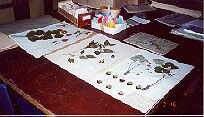Herbarium of the N.I.Vavilov All-Russian Research Institute of Plant Industry contains over 250,000 specimens of cultivated plants,
their wild relatives and weedy plants. It is a unique herbarium collection for all CIS countries and Europe, which enjoys the status of specialized
herbarium of global importance. In the VIR Herbarium of the cultural flora collections of the majority of cultivated plants and their wild relatives
have been assembled.
In the VIR's herbarium contained only cultivar/varietal specimens, the range of tasks which may be solved with its help would have been
significantly limited.
At present the collection is divided into the following sections:
- The main herbarium It contains cultivated plants and their wild relatives. The collection numbers about 250000 of sheets. Totally over
100 families, about 500 genera and over 4600 species are presented in the collection. The greatest part of the material of the main herbarium
fall on such families as Fabaceae, Poaceae, Rosaceae, which amount to about 2/3 of the collection.
- The herbarium of types. It represented by a collection of nomenclature types the majority of which belong to taxa of intraspecific rank, i.e.
out of 440 type specimens 20 are species and others are subspecies and varieties. They embrace 18 families and 42 genera. There are different ranks of type herbarium sheets: genus - 1 (Cerasolouisenia); species - 63; subspecies - 57; convarietas - 15; varietas -249; subvarietas - 22; forma -33.
- The general herbarium or herbarium of plants exotic for Russia. It embraces the samples which are sent from foreign herbarium collections
and which do not belong to the theme of the main VIR herbarium. This is an auxiliary herbarium used for wide-scale research on supraspecific
taxa, for preparing monographs on genera in which relations between taxa should be taken into account, for providing a wider range of services
to the users, lending included, for preparing volumes of the (Flora), as well as in specific research programs on agricultural plants, nectariferous,
ornamental plants, etc.
- The herbarium of weeds. It has been collected during the last 86 years and at present is the only herbarium in Russia, CIS countries and
Europe that reflects the whole range of plant species weeding crops in the CIS countries. It comprises 60000 specimens belonging to 93 families,
845 genera and 3507 species.
- Exchange herbarium (Delectus). This herbarium contains exchange materials and was set up for the purpose of replenishing VIR's herbarium
through exchanges with other botanical institutions. This herbarium was compiled by means of collecting from 40 to 60 plants of the same
taxonomic belonging from the same collecting site. The herbarium numbers about 14000 sheets. Content of the exchange stock is published in
the (Delectus plantarum) on the basis of which orders can be made.
 Since creation of the VIR's herbarium was not reduced to collecting varieties only, but pursued a wider objective of involving wild relatives of cultivated plants as well, the threat of narrow specialization of the collection has been escaped. A thorough study of a cultivated plant is impossible without tracing its origin, evolution, potential variation range, that is, without a simultaneous study of all wild relatives of this plant.
From this point of view, VIR's herbarium provides sample opportunities for research. Since creation of the VIR's herbarium was not reduced to collecting varieties only, but pursued a wider objective of involving wild relatives of cultivated plants as well, the threat of narrow specialization of the collection has been escaped. A thorough study of a cultivated plant is impossible without tracing its origin, evolution, potential variation range, that is, without a simultaneous study of all wild relatives of this plant.
From this point of view, VIR's herbarium provides sample opportunities for research.
Pursueing this objective, as well as that of expediting the search for and analysis of the data on the herbarium speciemens when solving
various research tasks, creation of dataware for the VIR's Herbarium was launched in 1995.
 Upon completing the IRS development and populating database fields, the following research tasks may be solved:
Upon completing the IRS development and populating database fields, the following research tasks may be solved:
- identification of gaps in the herbarium in terms of representation of large taxa and smaller systematic units of the Cultivated Plants and Wild Relatives of the Cultivated Plants (WRCP) in the collection, and in terms of sampling from the areas of their distriubution.
- elaboration of theoretical and methodological aspects of territories identification for the in situ preservation of WRCP;
- elaboration of strategies of plant introduction and core-collections setting proceeding from the results of eco-geographical analysis of the areas of distribution of WRCP;
- systematics and breeding-oriented morphological studies of herbarium specimens of the species widely represented in the VIR's Herbarium;
- varieties' approbation using the VIR's Herbarium database as a reference source.
The database of duplicate species offered in exchange is designed taking into consideration a wide range of aspects in herbarium studies, with due regard to nomenclature,
taxonomy, as well as geographical and ecological characteristics of a specimen.
|

 Since creation of the VIR's herbarium was not reduced to collecting varieties only, but pursued a wider objective of involving wild relatives of cultivated plants as well, the threat of narrow specialization of the collection has been escaped. A thorough study of a cultivated plant is impossible without tracing its origin, evolution, potential variation range, that is, without a simultaneous study of all wild relatives of this plant.
From this point of view, VIR's herbarium provides sample opportunities for research.
Since creation of the VIR's herbarium was not reduced to collecting varieties only, but pursued a wider objective of involving wild relatives of cultivated plants as well, the threat of narrow specialization of the collection has been escaped. A thorough study of a cultivated plant is impossible without tracing its origin, evolution, potential variation range, that is, without a simultaneous study of all wild relatives of this plant.
From this point of view, VIR's herbarium provides sample opportunities for research.

 Upon completing the IRS development and populating database fields, the following research tasks may be solved:
Upon completing the IRS development and populating database fields, the following research tasks may be solved: